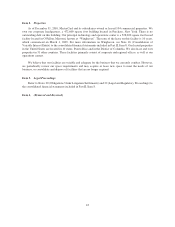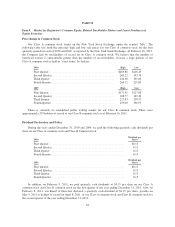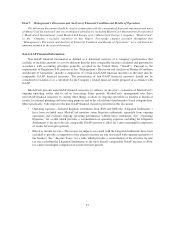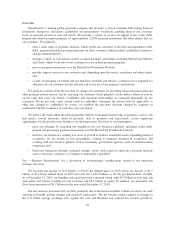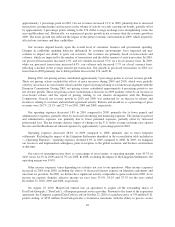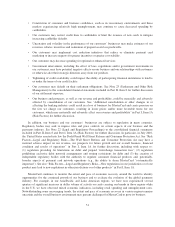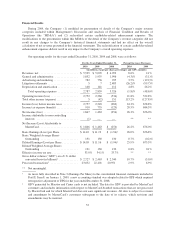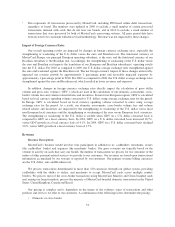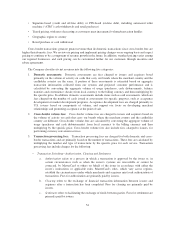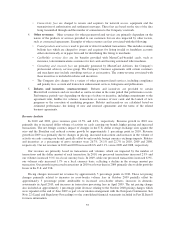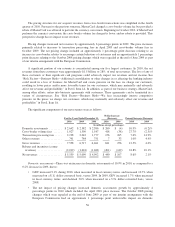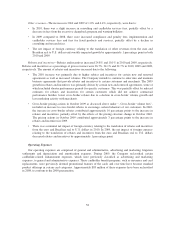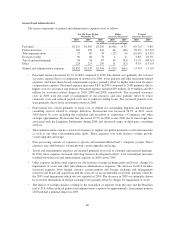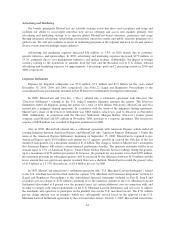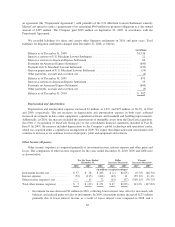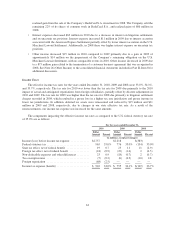MasterCard 2010 Annual Report Download - page 63
Download and view the complete annual report
Please find page 63 of the 2010 MasterCard annual report below. You can navigate through the pages in the report by either clicking on the pages listed below, or by using the keyword search tool below to find specific information within the annual report.3Data represents all transactions processed by MasterCard, including PIN-based online debit transactions,
regardless of brand. The numbers were updated in 2009 to exclude a small number of certain processed
transactions initiated with cards that do not bear our brands, and in 2010 to exclude a small number of
transactions that were processed by both of MasterCard’s processing systems. All prior period data have
been revised to be consistent with this revised methodology. Revenue was not impacted by these changes.
Impact of Foreign Currency Rates
Our overall operating results are impacted by changes in foreign currency exchange rates, especially the
strengthening or weakening of the U.S. dollar versus the euro and Brazilian real. The functional currency of
MasterCard Europe, our principal European operating subsidiary, is the euro, and the functional currency of our
Brazilian subsidiary is the Brazilian real. Accordingly, the strengthening or weakening of the U.S. dollar versus
the euro and Brazilian real impacts the translation of our European and Brazilian subsidiaries’ operating results
into the U.S. dollar. For 2010 as compared to 2009, the U.S. dollar average exchange rates strengthened against
the euro and weakened against the Brazilian real. The net foreign currency impact of these changes unfavorably
impacted net revenue growth by approximately 1 percentage point and favorably impacted expenses by
approximately 1 percentage point in 2010. For 2009 as compared to 2008, the U.S. dollar average exchange rates
strengthened against the euro and Brazilian real, which resulted in lower revenues and expenses.
In addition, changes in foreign currency exchange rates directly impact the calculation of gross dollar
volume and gross euro volume (“GEV”), which are used in the calculation of our domestic assessments, cross-
border volume fees and volume related rebates and incentives. In most non-European regions, GDV is calculated
based on local currency spending volume converted to U.S. dollars using average exchange rates for the period.
In Europe, GEV is calculated based on local currency spending volume converted to euros using average
exchange rates for the period. As a result, our domestic assessments, cross-border volume fees and volume
related rebates and incentives are impacted by the strengthening or weakening of the U.S. dollar versus most
non-European local currencies and the strengthening or weakening of the euro versus European local currencies.
The strengthening or weakening of the U.S. dollar is evident when GDV on a U.S. dollar converted basis is
compared to GDV on a local currency basis. In 2010, GDV on a U.S. dollar converted basis increased 10.7%,
versus GDV growth on a local currency basis of 9.1%. In 2009, GDV on a U.S. dollar converted basis declined
3.0%, versus GDV growth on a local currency basis of 1.7%.
Revenues
Revenue Descriptions
MasterCard’s business model involves four participants in addition to us: cardholders, merchants, issuers
(the cardholders’ banks) and acquirers (the merchants’ banks). Our gross revenues are typically based on the
volume of activity on cards that carry our brands, the number of transactions we process for our customers or the
nature of other payment-related services we provide to our customers. Our revenues are based upon transactional
information accumulated by our systems or reported by our customers. Our primary revenue billing currencies
are the U.S. dollar, euro and Brazilian real.
We process transactions denominated in more than 150 currencies through our global system, providing
cardholders with the ability to utilize, and merchants to accept, MasterCard cards across multiple country
borders. We process most of the cross-border transactions using MasterCard, Maestro and Cirrus-branded cards
and, among our largest markets, process the majority of MasterCard-branded domestic transactions in the United
States, United Kingdom, Canada and Brazil.
Our pricing is complex and is dependent on the nature of the volumes, types of transactions and other
products and services we offer to our customers. A combination of the following factors determines the pricing:
• Domestic or cross-border
53


